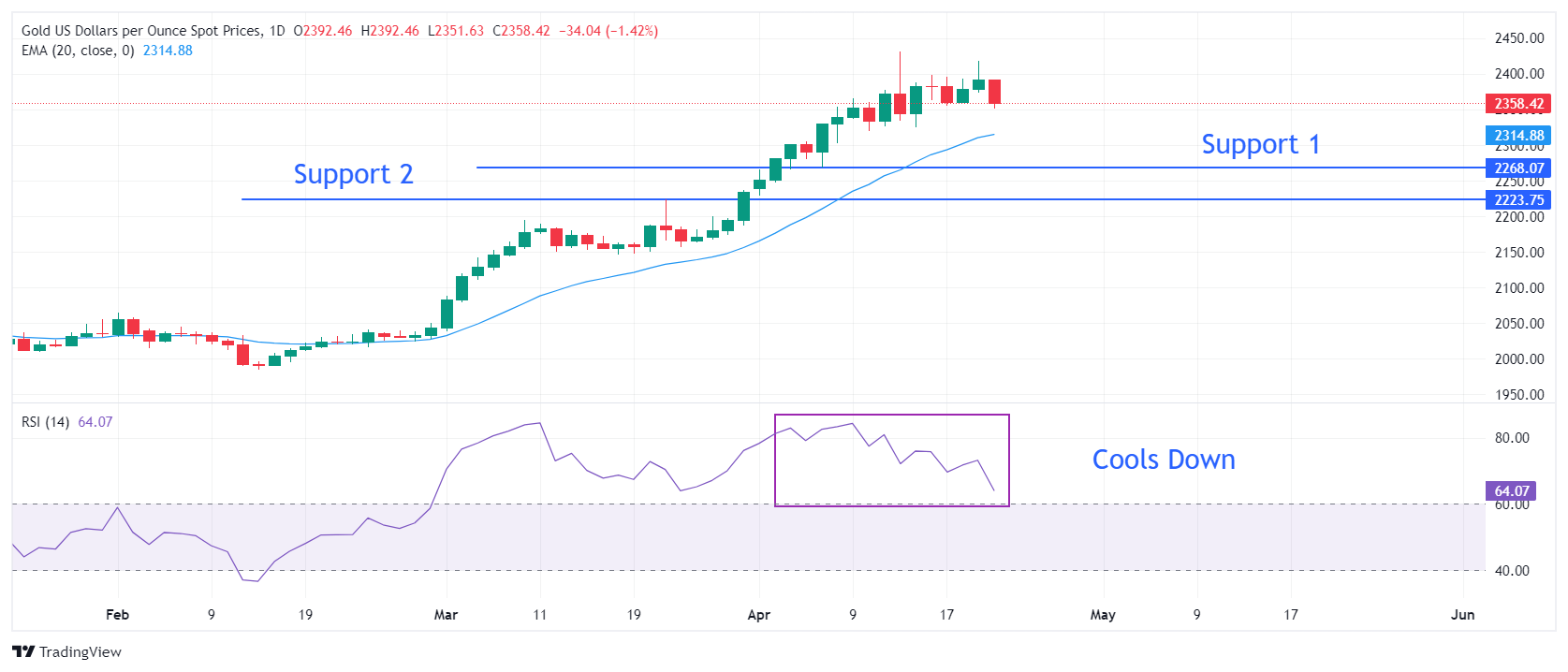- The price of Gold falls because investors do not see an immediate escalation of tensions between Israel and Iran.
- The prospects of a Fed interest rate cut, coupled with easing geopolitical fears, weigh on Gold.
- Austan Goolsbee, president of the Chicago Fed, said progress in controlling inflation has stalled.
Gold price (XAU/USD) falls vertically after failing to regain the crucial resistance of $2,400 in the American session on Monday, driven by lower safe haven demand as tensions in the Middle East ease.
The absence of a new escalation in tensions between Iran and Israel has provided some relief to the gloomy market sentiment. Furthermore, markets are increasingly discounting the possibility of the Federal Reserve (Fed) lowering interest rates at the June and July meetings, further weighing on Gold.
The 10-year US Treasury yield rises to 4.66%. Yields on low-interest-rate assets, such as U.S. bonds, rise on strong prospects that the Fed will be slower to cut rates compared to other central banks in developed countries. Rising bond yields, in turn, weigh on non-yielding assets, such as Gold, as they become a less attractive investment alternative.
This week, US March personal consumption expenditure (PCE) price index data will likely impact bond yields and gold prices. As the Fed's preferred inflation gauge, PCE data PCEs could change expectations about when the US central bank will start lowering interest rates. According to CME's FedWatch tool, markets currently expect the Fed to make the move at its September meeting.
Meanwhile, the US Dollar Index (DXY), which tracks the value of the US dollar against six major currencies, is consolidating in a tight range around 106.00. Gold is a dollar-denominated asset, so a firm US Dollar tends to keep its price in check.
Looking ahead, investors will focus on preliminary first-quarter Gross Domestic Product (GDP) data, due out on Thursday. The US economy is estimated to have grown by 2.5%. The strong growth highlights the strength of Consumer spending and increased production, resulting in greater pressure on prices. Higher GDP numbers would allow the Fed to keep interest rates at the current high levels, which would ultimately improve demand for the US dollar.
Daily summary of market movements: Gold price weakens as US yields rise
- The price of Gold falls to $2,330, after registering all-time highs near $2,430, as refuge demand decreases. Investors are less worried about a further escalation of tensions in the Middle East. On Friday, Tehran's air defense claimed to have destroyed a limited drone strike by Israel and confirmed that no damage had been done to nuclear facilities in the central Isfahan region. Iran has not announced any immediate retaliation plan, so investors do not see a major escalation in the short term, even if tensions between the two sides persist.
- The precious metal is under pressure after five weeks of gains as risk sentiment improves. Gold's appeal has remained on the rise despite the fading expectations of the Fed cutting interest rates in June. Prospects for rate cuts at the June and July meetings have faded after the March inflation report came in hotter than expected.
- Recent inflation data has undermined Fed policymakers' confidence that inflation will fall to the 2% target, and many have expressed a desire to keep interest rates higher for longer. On Friday, Chicago Fed President Austan Goolsbee stated: “Given the strength of the labor market and the progress in reducing inflation seen over a longer arc, I believe the Fed's current tight monetary policy is adequate,” Reuters reported.
- Goolsbee said higher-than-expected inflation data for the first three months of the year “cannot be discounted,” and advised the Fed to determine whether continued strong growth in the economy and labor market is a sign of overheating.
Technical analysis: The price of Gold extends its fall to $2,330

The price of Gold is approaching $2,330 after falling from $2,418. A mean reversion move is anticipated in the yellow metal, which will drag it to the 20-day exponential moving average (EMA) around $2,315. Typically, Gold reverses its trend towards the 20-day EMA after a strong rally. However, the move is usually considered a correction, not a bearish reversal.
On the downside, the April 5 low near $2,268 and the March 21 high at $2,223 will be the main support areas.
The 14-period RSI cools to 64.40 after becoming extremely overbought. The overall outlook for the asset remains strong if the RSI moves towards the bullish range of 60.00-80.00.
Frequently asked questions about Gold
Why invest in Gold?
Gold has played a fundamental role in human history, as it has been widely used as a store of value and medium of exchange. Today, apart from its brilliance and use for jewelry, the precious metal is considered a safe haven asset, meaning it is considered a good investment in turbulent times. Gold is also considered a hedge against inflation and currency depreciation, since it does not depend on any specific issuer or government.
Who buys more Gold?
Central banks are the largest holders of Gold. In their aim to support their currencies in turbulent times, central banks tend to diversify their reserves and purchase Gold to improve the perception of strength of the economy and currency. High Gold reserves can be a source of confidence for the solvency of a country. Central banks added 1,136 tons of gold worth about $70 billion to their reserves in 2022, according to data from the World Gold Council. This is the largest annual purchase since records exist. Central banks in emerging economies such as China, India and Türkiye are rapidly increasing their gold reserves.
What correlation does Gold have with other assets?
Gold has an inverse correlation with the US Dollar and US Treasuries, which are the main reserve and safe haven assets. When the Dollar depreciates, the price of Gold tends to rise, allowing investors and central banks to diversify their assets in turbulent times. Gold is also inversely correlated with risk assets. A rally in the stock market tends to weaken the price of Gold, while sell-offs in riskier markets tend to favor the precious metal.
What does the price of Gold depend on?
The price of Gold can move due to a wide range of factors. Geopolitical instability or fear of a deep recession can cause the price of Gold to rise rapidly due to its status as a safe haven asset. As a non-yielding asset, the price of Gold tends to rise when interest rates fall, while rising money prices tend to weigh down the yellow metal. Still, most of the moves depend on how the US Dollar (USD) performs, as the asset is traded in dollars (XAU/USD). A strong Dollar tends to keep the price of Gold in check, while a weaker Dollar is likely to push up Gold prices.
Source: Fx Street
I am Joshua Winder, a senior-level journalist and editor at World Stock Market. I specialize in covering news related to the stock market and economic trends. With more than 8 years of experience in this field, I have become an expert in financial reporting.







